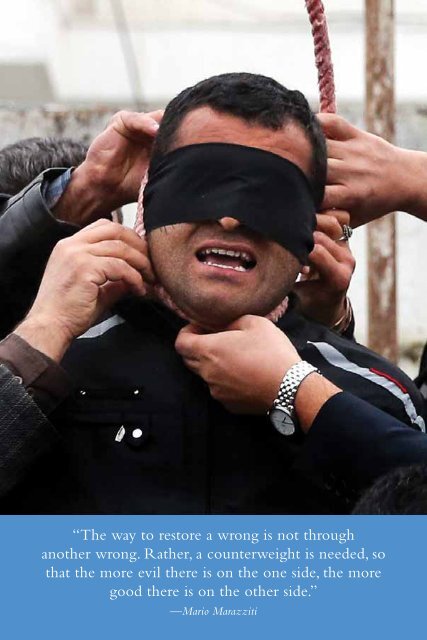PENALTY
DBk0302s7Xm
DBk0302s7Xm
Create successful ePaper yourself
Turn your PDF publications into a flip-book with our unique Google optimized e-Paper software.
“The way to restore a wrong is not through<br />
another wrong. Rather, a counterweight is needed, so<br />
that the more evil there is on the one side, the more<br />
good there is on the other side.”<br />
Parents of victim granting mercy to convicted murderer by removing the rope from around his neck and halting the execution at the last minute. © EPA/Arash Khamooshi<br />
CHAPTER 4<br />
VALUES<br />
This chapter, which focuses on values, contains articles by a Catholic nun who<br />
works with prisoners on death row, two authors active in both civil society<br />
and politics and two experts in human rights. Sister Helen demonstrates the<br />
fruitlessness of the death penalty from the perspective of the healing process for<br />
family members of the victims. Marazziti finds arguments against the death<br />
penalty in the world’s religions, while Bhatti warns of its social and political<br />
dangers. Rodley describes the evolution of Human Rights Committee’s jurisprudence<br />
on the death penalty, while Heyns focuses on the right to life and<br />
the way that the UN and regional bodies increasingly interpret it to reduce the<br />
scope of the death penalty.<br />
Helen Prejean, a Catholic nun, has for over three decades engaged in accompanying<br />
the condemned on death row and through this experience, has also<br />
come to know many murder victims’ families. From her experience, wounded<br />
and grieving families—even after many years of waiting—can never be healed<br />
by watching the Government kill the perpetrators. What they need instead are<br />
compassionate people who will accompany them on the long road to healing,<br />
as well as counselling and sometimes financial help.<br />
Mario Marazziti, an Italian parliamentarian and affiliate of the Community<br />
of Sant’Egidio, a Christian lay association, examines the doctrines of<br />
Buddhism, Hinduism, Judaism, Islam and Christianity as they apply to the<br />
death penalty, looking for arguments against it. Each of these large, complex<br />
communities of believers has an ancient tradition that has inspired both reverence<br />
for life and, sometimes, support for the taking of life. But while individual<br />
believers have sometimes chosen death, he argues, these religions’ core teachings<br />
emphasize the sacredness of life.<br />
For Dr. Paul Bhatti, civil society activist and former Minister for National<br />
Harmony and Minorities Affairs in Pakistan, giving or taking a human life is<br />
a divine prerogative. However, there are social and political arguments against<br />
the death penalty as well. National criminal justice systems are less than<br />
perfect, and the death penalty can be misused against political opponents. He<br />
argues that imposing the death penalty on terrorists is dangerous, as it may<br />
transform criminals into martyrs, justify the taking of life, and aid future<br />
recruitment.<br />
—Mario<br />
184<br />
Marazziti<br />
185


